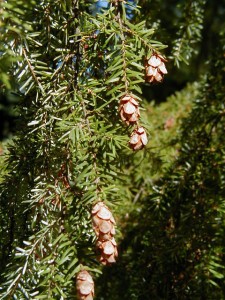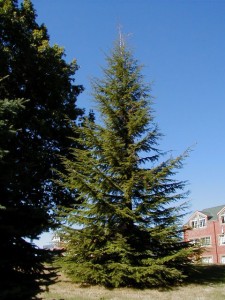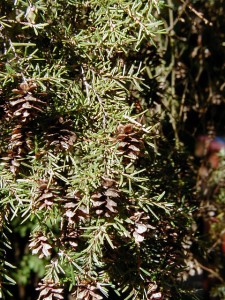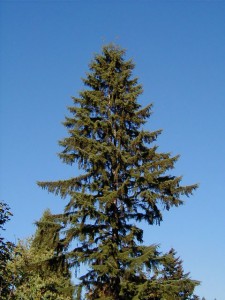Genus: Tsuga
Family: Pinaceae
Schoolchildren in Oregon learn to recognize these trees by hearing the story of poor Harry Hemlock. Harry was playing with his friends one day and he didn’t hear his teacher call him to select a cone. Cindy Cedar heard the call and ran up to get a good cone. Doug Fir heard the call and ran to get a good cone. But, by the time Harry looked up and saw what was happening, it was too late. All the good cones were gone and poor Harry was stuck with tiny little cones and he could only hang his head in shame. Ever since then, hemlocks have been easy to recognize by their tiny cones and the tops that hang over to the side. (Moral: Pay attention to your teachers.)
Japanese Hemlock
Scientific name: Tsuga diversifolia
 This conifer is native to Japan and grows near timberline. It is the most frost-hardy and wind-tolerant of the hemlocks. It can grow to about 75 feet but often remains shrub size because of its native habitat.
This conifer is native to Japan and grows near timberline. It is the most frost-hardy and wind-tolerant of the hemlocks. It can grow to about 75 feet but often remains shrub size because of its native habitat.
View tree page and map.Mountain Hemlock
Scientific name: Tsuga mertensiana The Mountain Hemlock is possibly the least adaptable of the hemlocks. In its native habitat it attains a height of 50 to 90 feet, but it is slow growing and smaller under cultivation. The needles are a blue-green to gray-green color and give a bottle-brush effect by growing all around the stem. Cones are 1/2 to 3 inches, cylindrical, hanging down from the branches and are purple when new. It thrives where the growing season is short and winters are long and cold.
The Mountain Hemlock is possibly the least adaptable of the hemlocks. In its native habitat it attains a height of 50 to 90 feet, but it is slow growing and smaller under cultivation. The needles are a blue-green to gray-green color and give a bottle-brush effect by growing all around the stem. Cones are 1/2 to 3 inches, cylindrical, hanging down from the branches and are purple when new. It thrives where the growing season is short and winters are long and cold.
View tree page and map.Western Hemlock
Scientific name: Tsuga heterophylla

